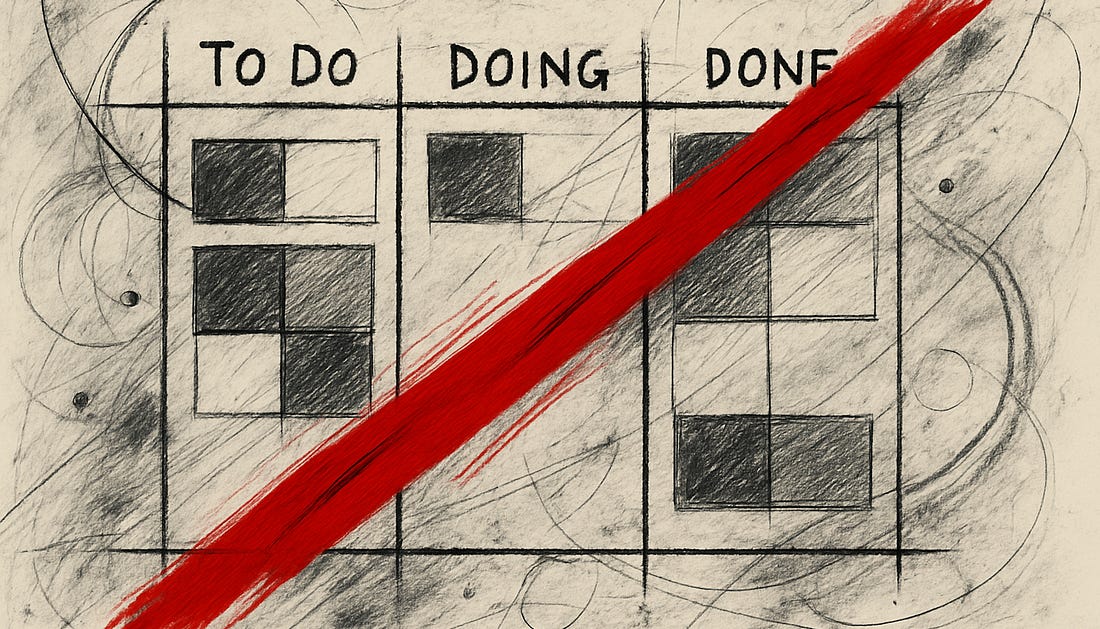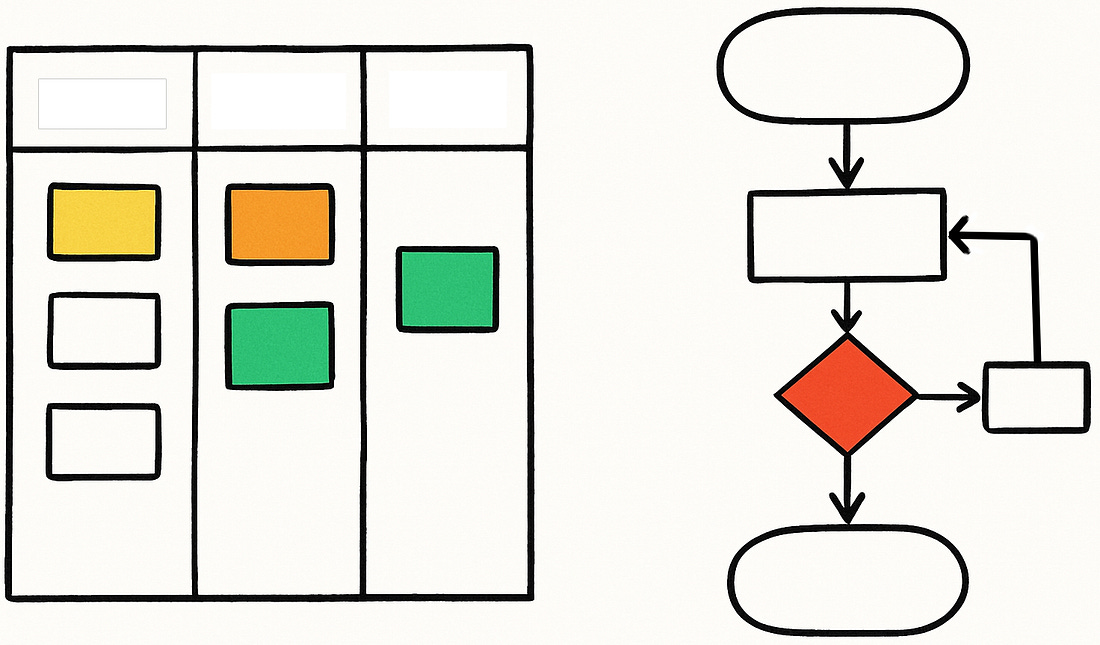|
 |
Scouting the Future of Work Between Hype and Doom
Kanban Must Evolve in the Age of AI
Why Linear Workflow Visualization Is Doomed in a Nonlinear, AI-Driven World
It’s been a while since human operators agonized over taxi ride logistics and package deliveries. In the age of AI, machines now handle complex, dynamic workflows, while signaling humans what to do and when to bring what to whom.
Before the Kanban community clutches their pearls in outrage over my critical perspective, let’s first distinguish between the Kanban concept, the Kanban method, and Kanban boards. (Because trust me, if I don’t spell it out, the angry mob will flood the comments.)
Kanban versus Kanban versus Kanban
The Kanban concept originated at Toyota in the 1940s as a scheduling system to improve manufacturing efficiency. Inspired by supermarket inventory management, it used visual cards (“kanban” means “signboard” in Japanese) to signal demand and control the workflow. It later developed into a broader method for managing work in progress. Loosely translated into three words, Kanban means “show the flow.”
In 2007, David J. Anderson and others formalized the Kanban method, applying kanban principles to knowledge work (whereas Jim Benson did the same for Personal Kanban). The method, both for teams and individuals, emphasizes visualizing workflows, limiting work-in-progress, managing flow, making process policies explicit, and implementing collaborative evolution. Loosely summarizing Kanban’s principles: it’s all about visualizing and optimizing the flow of value.
Finally, a Kanban board is a specific visual management tool that represents work items as cards moving across columns reflecting workflow stages (e.g., To Do, In Progress, Done). It helps teams visualize work, track progress, and limit work-in-progress.
I don’t expect to ruffle many feathers in the Kanban community when I say that the Kanban board is an implementation of the Kanban method, which is an adaptation of the Japanese Kanban concept. (But I guarantee someone will still respond with corrections. Because, you know—people.)
So far, so good.
Now, the following observations are to a large extent about Kanban boards (and to a smaller extent about the kanban concept).
In the age of AI, they need to evolve.
(If you’re already convinced, feel free to skip the examples.)
Example 1: Video Editing
Let me begin with a concrete example.
I create many videos for a self-paced online learning course. For a single video, I often need multiple assets. I shoot outdoor videos depending on the weather, my location, and available time. I record footage in my office studio during rare, quiet days with an empty calendar. Sometimes, I collect AI-generated videos or stock footage (“B-roll”), but only when the main recordings are insufficient. In other words, there’s no predictable process for collecting video assets—video asset collection is best described as context-driven chaos.
Once I start editing and assembling everything, the process becomes quasi-predictable: trimming clips, normalizing audio, generating subtitles, blurring backgrounds, adding transitions and effects, inserting intros and outros, and exporting to MP4. I have a simple checklist and I usually progress top-to-bottom. With experience, I operate almost on autopilot—except when the video editor crashes, the hard drive fills up, or files get corrupted—all of which happened to me in a single day. (I recommend pairing such a day with chamomile tea and chocolate.)
Then it gets complicated again. After generating the main video (with subtitles) for the self-paced course, I might offer the same assets to the M3K team for marketing. But they want portrait reels instead of landscape videos. And we haven’t even started translations. Traditionally, this would involve generating separate video files for different languages: a lot of extra work. However, in the age of AI, it’s now possible to create alternative versions with my digital avatar dubbing in foreign languages. And when a customer will pay for it, why not generate versions with their logo and in their language?
Conclusion: video editing is a nonlinear process. Each video production differs, and optimizing the workflow becomes remarkably complex. Rather than visualizing it as a linear sequence of steps, it’s more realistic to conceptualize it as a messy flowchart. As any film crew.
Example 2: Book Publishing
Here’s another example I’m intimately familiar with.
When writing a book, I don’t move individual chapters from left to right across a Kanban board because that makes little sense. All chapters typically exist in the same state—Research, Draft, Rewrite, Editing, Revisions, etc. They move from one state to another together because there are countless interdependencies between chapters.
Sometimes chapters grow too large while others remain too small, requiring me to balance them out for the overall reader experience. A story told early might fit better with a topic later in the book, leading to a reshuffle of the narrative. New insights gained while writing later sections often necessitate partial rewrites of earlier material. Furthermore, feedback from beta readers and proofreaders triggers various edits throughout the entire book to enhance flow, consistency, and comprehension.
It’s only when I hit the Upload button that all chapters are “Done.” And even then, what exactly makes up “the book”? Human Robot Agent is available in three versions: e-book, softcover, and hardback, distributed across multiple platforms: Amazon, Apple, Google, Kobo, IngramSpark, and others. There isn’t one unique “book” with a clearly defined “Published” status. There are many. (It’s like Schrödinger’s book: published and unpublished—simultaneously.)
Complexity compounds when a conference organizer requests thirty softcovers or hardbacks (with my exclusive author discount—hint, hint 😉 ). Amazon likely ships those books in multiple packages, each with its own tracking number and delivery date. They might even follow different routes to their destination! Good luck tracking that on a single Kanban board.
Conclusion: book publishing is a nonlinear process. All book editions and orders differ, and management resembles a network of interconnected value streams rather than a linear progression. It’s not a pipeline; it’s a spaghetti monster.
Example 3: Dining
Let’s examine an example closer to everyone’s personal experience.
Is it possible, in any regular restaurant, to visualize workflows as linear value streams? Can a restaurant’s Kanban board show step-by-step progression of guests through Seating, Drinks, Appetizers, Main, Dessert, and Payment? Or should individual food and drink orders move across the board? Both approaches prove problematic.
What if one patron wants two appetizers instead of a main (as I sometimes do)? What if another guest prefers dessert before their main course? (My rather unconventional best friend comes to mind.) What if multiple guests order the same dish? Will the kitchen prepare them independently or batch them together?
What happens when someone joins a party later while others have already started their main course? What if separate parties unexpectedly discover each other and decide to join tables? What if someone sends a dish back to the kitchen? What if a couple breaks up mid-meal and one leaves, insisting on paying only their share?
I’ve never seen a server use a Kanban board—not because carrying a tray with a pack of sticky notes is inconvenient, but because the diverse preferences of dinner guests defy any visualization of a “standard” dining experience.
Unsurprisingly, more restaurants now employ automation to manage the increasing complexity of menu items versus guest preferences through online menus, QR codes, order tablets, and payment terminals. Just yesterday, I heard someone complimenting a restaurant because their software allowed easy bill-splitting. The only task remaining for servers (or robots) is following the computer’s instructions to bring the right tray to the right table.
Conclusion: dining is a nonlinear process. Each guest desires a unique experience, and management of the wide variety of value streams gets automated.
Drowning in AI hype? Tired of AI doom? With my work, I aim to chart a third path—skeptical, but forward-thinking, steering between evangelists and apocalyptics. Subscribe to my Substack to get my take on the future of work.

